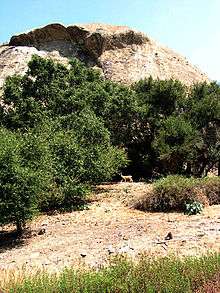Occidental College
Occidental College (informally Oxy) is a private liberal arts college in Los Angeles, California. Founded in as a coeducational college in 1887 by clergy and members of the Presbyterian Church, it became non-sectarian in 1910. It is one of the oldest liberal arts colleges on the West Coast of the United States.
 | |
| Motto | Occidens Proximus Orienti (Latin) |
|---|---|
Motto in English | The West is nearest the East |
| Type | Private |
| Established | April 20, 1887 |
Religious affiliation | Non-sectarian (historically Presbyterian) |
| Endowment | $448.1 million (2019)[1] |
| President | Harry J. Elam, Jr. |
Academic staff | 183 |
| Students | 1,930 (Fall 2019)[2] |
| Undergraduates | 1,930 (Fall 2019)[2] |
| Location | , , United States 34.12715°N 118.21090°W |
| Campus | Urban 120 acres (49 ha) |
| Colors | Orange and Black |
| Athletics | NCAA Division III – SCIAC |
| Nickname | Tigers |
| Affiliations | NAICU[3] Annapolis Group Oberlin Group CLAC |
| Sports | 21 varsity teams |
| Mascot | Oswald the Tiger |
| Website | Oxy.edu |
 | |
The college values and emphasizes diversity and global literacy, via its student demographics and academic requirements.
History
Early history
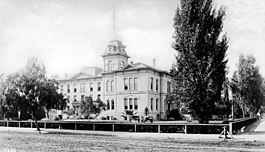
Occidental College was founded on April 20, 1887, by a group of Presbyterian clergy, missionaries, and laymen, including James George Bell, Lyman Stewart, and Thomas Bard. The cornerstone of the school's first building was laid in September 1887 in the Boyle Heights now East Los Angeles neighborhood of Los Angeles.[4] The college's first term began a year later with 27 male and 13 female students, and tuition of $50 a year.[5]
In 1896, the Boyle Heights building was destroyed by fire. The college temporarily relocated to the old St. Vincent's College campus on Hill Street before a new site was selected in Highland Park in 1898.[4] Eventually, the college erected three main buildings: the Academy Building, the Stimson Library, and the Hall of Arts and Letters (the Hall still stands today, converted to apartments).[6] The Highland Park site was also bisected by the tracks of the Santa Fe Railroad,[6] and was the site of two presidential visits, first by William Howard Taft in 1909 and subsequently by Theodore Roosevelt in 1911.[6]
In 1909, the Pomona College Board of Trustees suggested a merger between Pomona and Occidental, but the proposal came to nothing.[7] The following year, the college severed formal ties with the Presbyterian Church and became a non-sectarian, non-denominational institution.[4][8] The small size of the 15-acre (6.1 ha) campus and the disruption caused by frequent freight trains pushed the college's trustees to find a new location.[6]
1900s
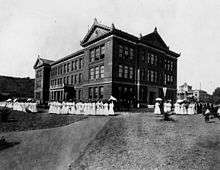
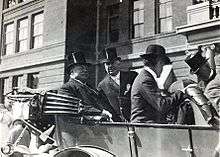
In 1912, the school began construction of a new campus located in Los Angeles' Eagle Rock neighborhood. The Eagle Rock campus was designed by noted California architect Myron Hunt, also known as the planner of the California Institute of Technology (Caltech) campus and as designer of the Huntington Library and Art Gallery and the Rose Bowl. That same year, Occidental President John Willis Baer announced the trustees' decision to convert Occidental College into an all-men's institution. However, students and faculty protested, and the idea was abandoned.[9][10]
In 1913, the Occidental College Board of Trustees announced plans to convert the college exclusively to a men's school. The plans were met with widespread backlash from students and faculty who protested the change. The community outcry garnered national headlines and the board later dropped the proposal.[11]
Two weeks after Booker T. Washington came to visit Occidental, on March 27, 1914, Swan, Fowler, and Johnson Halls were dedicated at its new Eagle Rock campus. Patterson Field, today one of the oldest collegiate sports stadiums in Los Angeles, was opened in 1916.[12] In April 1917, shortly after the United States entered World War I, the college formed a Students Army Training Corps to aid the war effort.[5]
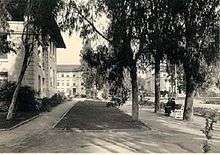
Under Occidental President Remsen Bird, the school opened a series of new Hunt-designed buildings, including Clapp Library (1924), Hillside Theatre and a women's dormitory (Orr Hall) in 1925, Alumni Gymnasium (1926), the Freeman Student Union (1928) and a music and speech building (1929).[13] The Delta of California chapter of Phi Beta Kappa was established at Occidental in 1926, at a time when the only other chapters in California were at Stanford, UC Berkeley, and Pomona.[5]
English novelist Aldous Huxley, who spoke at Occidental's convocation ceremony in the then-new Thorne Hall in 1938, lampooned President Remsen Bird as Dr. Herbert Mulge of Tarzana College in his 1939 novel, After Many a Summer Dies the Swan. Huxley was never again invited back to campus.[14]
During World War II, many students left Occidental to fight in the war. In July 1943, the U.S. Navy established a Navy V-12[15] officer training program on campus that produced hundreds of graduates before it was disbanded in 1945 at the end of the war. Occidental President Remsen Bird worked behind the scenes to help Oxy students of Japanese descent continue their education despite mandatory evacuation orders; his letters are included in the Japanese American Relocation Collection in Clapp Library.[16]
After having its first Rhodes Scholar, Clarence Spaulding, named in 1908, Oxy seniors John Paden and Aaron Segal were awarded Rhodes Scholarships in 1958; the first and only time Occidental has produced two Rhodes Scholars in a single year.[17] Rhodes scholars Aaron Segal and John Paden were among the 10 Occidental students who participated in Crossroads Africa that year, a forerunner to the Peace Corps that later became a national program.[18]
In 1969, 42 students were suspended for peacefully protesting military recruiting on campus. One year later, faculty voted to suspend classes in the wake of the Kent State shootings and America's invasion of Cambodia. Subsequently, Oxy students wrote 7,000 letters to Washington D.C., protesting U.S. involvement in the war in Southeast Asia.[19] Occidental launched one of the country's first Upward Bound programs in 1966, aimed at increasing the number of low-income, underrepresented high school students who become the first in their family to go to college.
Also in 1969, the school opened its first two co-ed dormitories, and two more followed a year later. In 1988, John Brooks Slaughter, formerly Chancellor of the University of Maryland,[20] became Occidental's first black president.[21] Building on faculty and student advocacy and a series of grants the college had received previously to increase the diversity of the Occidental student body, Slaughter led the process of creating a new mission statement that is still used today.[22] Also, Slaughter led the college's community outreach expansion with the creation of the Center for Volunteerism and Community Service, the predecessor for the current Center for Community Based Learning.[23]
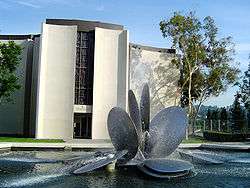
In November 1990, the college, initially established as a Presbyterian institution but is no longer religiously affiliated,[24] rededicated the campus' main chapel as the Herrick Memorial Chapel and Interfaith Center. The school also took down the crosses in the chapel in an attempt to "broaden Occidental's appeal among non-Christian students".[25]
2000s
In July 2006, Susan Westerberg Prager became Occidental's first female president. She left her position in 2007 during the fall term.[26] Robert Skotheim the former president of Whitman College and the Huntington Library, then served as interim president. In July 2009, Jonathan Veitch, formerly dean of The New School's Eugene Lang College, became Occidental's 15th president and the first to be a native Angeleno.[27]
The college received some national scrutiny in 2014 when the U.S. Department of Education named Occidental College as one of 55 higher education institutions under investigation "for possible violations of federal law over the handling of sexual violence and harassment".[28] In response to student and faculty outcry the college adopted a new interim sexual misconduct policy, hired a former assistant district attorney as a full-time, independent Title IX coordinator, and added a new 24-hour, 7-days-a-week telephone hotline. The school also created a permanent Sexual Misconduct Advisory Board made up of students, faculty, and staff.[29][30][31] Two years later, the investigation was concluded with the Office of Civil Rights finding that "the preponderance of the evidence does not support a conclusion that the College violated Title IX, except with respect to the issue of promptness in several cases during the 2012-13 school years."[32]
President Barack Obama attended Occidental for two years prior to transferring to Columbia University. In 2015, "birthers" falsely claimed that Obama's Occidental College transcript revealed he received financial aid as a foreign student from Indonesia after the resurgence of a fake news story from 2009.[33]
In July 2020, Harry J. Elam, Jr., formerly vice provost for undergraduate education at Stanford University and renowned for diversity and inclusion initiatives in liberal arts curricula, became Occidental’s 16th president.[34]
Campus
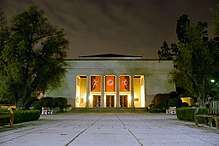
Architect Myron Hunt created the original campus master plan for Occidental's Eagle Rock campus in 1911. He structured the campus in a Mediterranean style, with covered walkways and tile roofs. The campus landscape was designed and developed by Beatrix Farrand in the late 1930s. All of the 19 buildings designed by Hunt remain in use today, including Johnson Hall, now the home for the McKinnon Center for Global Affairs.[35][36]
Built on a hillside, the Eagle Rock campus covers over 120 acres (49 ha), some of which is undeveloped land that includes a local landmark known as Fiji Hill. There are 12 on-campus residence halls and the main dining facility is The Marketplace, which is located in the Johnson Student Center. Some buildings, such as the Hameetman Science Center (designed by Anshen + Allen, 2003), deviates from the original architecture with its large glass windows and metal balconies (its lobby houses a large Foucault pendulum). In 1979, Occidental installed Water Forms II, a kinetic fountain designed by professor George Baker. The fountain is a campus landmark and was featured prominently in the 1984 film Star Trek III: The Search for Spock.
The campus is also noted for its outdoor Remsen Bird Amphitheater, also called the Remsen Bird Hillside Theatre, where between 1960 and 1996, a season of summer plays were performed, including Shakespeare plays and musicals.[37] However, financial cutbacks caused the theater department to end its summer festival programs.[37] Since 1996 the Occidental Children’s Theater has instead performed there each summer.[38][39][37]
In 1989, the college dedicated Keck Theater, a post-modern theater with a movable stage and seating arrangements for a variety of different types of shows. It was designed by the architectural firm of Kanmnitzer and Cotton. The James Barrie version of the play Peter Pan was the first show performed at the opening ceremony in the summer of 1989.
Occidental College was ranked as the sixth "Most Beautiful" campus by Newsweek in 2012.[40] The campus is home to a 1-megawatt ground-mounted solar array, which is the largest hillside array on an American college campus and the largest of its kind in Los Angeles.[41][42] The 4,886-panel installation was completed in Spring 2013 and inaugurated on the school's 126-year anniversary.[41]
Academics
Degree programs
There are 34 majors offered on campus (and nine minor-only programs, including Public Health, Linguistics, and Classical Studies) and a 9:1 student–faculty ratio. The average class size is 18 students and most students take four classes per semester.[43]
Rankings
| University rankings | |
|---|---|
| National | |
| Forbes[44] | 102 |
| THE/WSJ[45] | 99 |
| Liberal arts colleges | |
| U.S. News & World Report[46] | 39 |
| Washington Monthly[47] | 62 |
Since 1908, Occidental has graduated 10 Rhodes Scholars.[48] The 2017 edition of the Fiske Guide to Colleges gave Occidental four-star ratings (out of five) in academics and quality of life. Princeton Review's The Best 381 Colleges 2017 Edition gave Occidental ratings of 91 (out of 100) in academics and quality of life and 95 in financial aid. In Forbes' 2019 ranking of America's Top Colleges, Occidental ranks 102nd out of 650 liberal arts colleges, universities and service academies.[49] In U.S. News & World Report's 2020 rankings of American liberal arts colleges, Occidental is ranked tied for 39th overall, 67th for "Best Value", and tied at 90th for "Top Performers on Social Mobility.[50] Kiplinger's "Best College Values 2019" rankings places Occidental 58th among 149 liberal arts colleges.[51]
Admissions
Fall Admission Statistics
| 2018[52] | 2017[53] | 2016[54] | 2015[55] | 2014[56] | 2013[57] | 2012[58] | |
|---|---|---|---|---|---|---|---|
| Applicants | 7,281 | 6,775 | 6,409 | 5,911 | 6,071 | 6,072 | 6,135 |
| Admits | 2,716 | 2,831 | 2,936 | 2,652 | 2,552 | 2,574 | 2,412 |
| Admit Rate | 37.3% | 41.7% | 45.8% | 44.8% | 42.0% | 42.3% | 39.3% |
| Enrolled | 566 | 566 | 502 | 517 | 546 | 548 | 530 |
U.S. News deemed Occidental's admissions "more selective," with the class of 2020 acceptance rate being 37.3%.[59] Of those admitted submitting such data, 52% were in the top 10% of their high school class. The SAT 25th - 75th percentile scores were 1810-2120.[60] Of those admitted to the class of 2020, 50% identified as persons of color, and 13% of those admitted were international students.[61]
Core program
Divided in three parts, the Core Program was designed by the faculty of Occidental to unify and enhance the liberal arts education offered by the school. The Core Program requires students to achieve the following:
- complete two first-year writing seminars; one course in the fall, another in the spring (called CSPs);
- complete a set number of courses in 3 of 6 available geographical areas worth at least 12 units: Africa and the Middle East, South, Central and East Asia, Europe, Latin America, the United States, Intercultural
- complete a 102-level language course or be exempt through four ways
- complete a course concerning the pre-1800s era and one focused on the fine arts
- complete three math and science courses; one has to be a lab science
- pass a senior-year comprehensive examination within the student's chosen major.[62]
First-year seminars (eight course hours in total) are the centerpiece of the Core Program. Students are given a variety of class choices to fulfill the seminar requirement and to satisfy the first-year writing requirement. While the classes range in topic, each is based on a curriculum of cultural studies. The classes are designed to expose students to the rigor of college academics and to the four principles of the college mission—Excellence, Equity, Community, and Service.
The Core Program's emphasis on global literacy requires students to take a minimum of three courses that touch on at least three of the following geographical areas: Africa and the Middle East; Asia and the Pacific; Europe; Latin America; the United States; and Intercultural. Students are also required to demonstrate proficiency in writing and in a foreign language and take courses in the fine arts and in the sciences, mathematics, or other courses that address formal methods of reasoning.
The final portion of the Core Program requires students to pass a senior comprehensive examination in their chosen field. Comprehensive examinations may include seminars, creative projects, fieldwork, oral exams, theses, or field research projects.
Exchange and cooperative joint degree programs
California Institute of Technology and Columbia University
Students at Occidental can take courses at the California Institute of Technology (Caltech) in nearby Pasadena free of charge. In addition, a 3-2 engineering program allows qualified students the opportunity to study at Occidental for three years, completing their undergraduate experience with an additional two years either at Caltech or Columbia University. At the end of the five years, the student receives two degrees, a Bachelor of Arts in the Combined Plan from Occidental and a Bachelor of Science in the selected field of engineering from the engineering school.
Art Center College of Design
Art majors at Occidental College can take courses at the Art Center College of Design in Pasadena, one of the country's top-ranked art schools. The program is not open to first-year students, but as with the Caltech exchange program, students receive full course credit. No additional tuition payments are required.
Columbia University School of Law
With a competitive GPA and LSAT scores, Columbia Law School admits students upon completion of their junior year at Occidental into its Accelerated Interdisciplinary Program in Legal Education. Admittance to the program enables students to earn a bachelor's degree from Occidental and a law degree from Columbia in six years.
Keck Graduate Institute
Students who are interested in biotechnology and who become a biochemistry major maintaining a 3.2 GPA in the necessary courses will be guaranteed admission to the Keck master's in bioscience program. The Keck Graduate Institute is part of the Claremont Colleges consortium.
Student life
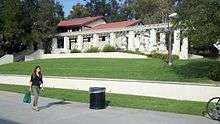
At the beginning of every school year, freshmen participate in Convocation, a formal ceremony welcoming new students to the college in which the faculty wear their full academic regalia and students don robes.[63] Founders Day is celebrated annually at the school on April 20, the day in 1887 when Occidental's incorporation papers were officially signed by the California Secretary of State.[64]
For the first three years at Occidental, all students are guaranteed housing on campus and for seniors it is optional. Freshmen do not get to choose where they live; the Office of Residential Education & Housing Services arranges housing by pairing students based on a short form students fill in the summer before they arrive on campus. The Occidental College dorm life consists of 13 co-ed residential housing facilities.
After a student's first year, he or she can choose to live in a number of dorms that house sophomores, juniors, and seniors; one-third of all these halls are reserved for each grade. These dorms include Newcomb Hall, Wylie Hall, Erdman Hall, Haines Hall, Rangeview Hall and Stearns Hall.
There are also themed-living communities which consist of the Multicultural Hall in Pauley (open to all years), all-women housing (Berkus House, named after alumnus Dave Berkus), the E. Norris Hall, the Queer House, and the Food Justice house.[65]
Student activities
.jpg)
Occidental College has various student-run clubs, organizations and ventures such as the Green Bean Coffee Lounge, organic garden, and the student-managed bike sharing and repairing program. There are also traditional groups such as glee club, Greek organizations, and student media outlets.
Media
The campus newspaper is The Occidental, an independent, student-run publication. It has been published continuously since 1893.[66] As of the 2019–20 school year, The Occidental publishes biweekly in print and weekly online.
KOXY is a student-run campus radio station, in operation in the 1960s and 1970s, and again since 2000.[67] It originally operated on the frequency 104.7 in and around campus from 1968 to 2009, but switched to only being available by webstream in 2009. KOXY sponsors several on-campus events.
In 2010, Occidental College launched a TV station called CatAList, launched by then-students Daniel Watson and Raffy Cortina;[68] Cortina was also the first Occidental student to be awarded with a Student Academy Award from the Academy of Motion Picture Arts and Sciences for his short Bottled Up.[69] The station produces 20–30 minutes of student-run content weekly on a variety of topics.
Greek life
Occidental College's Greek Council consists of eight members: local sororities Alpha Lambda Phi Alpha, Delta Omicron Tau; national sorority Kappa Alpha Theta; local fraternity Zeta Tau Zeta (co-ed), and national fraternity, Sigma Alpha Epsilon.[70] These greek organizations are social organizations as opposed to academic greek organizations. Occidental has a fall and a spring greek recruiting period; first year students are first eligible to participate in greek recruitment during the spring of their first year. Occidental also has two cultural greek organizations: Kappa Alpha Psi and Sigma Lambda Gamma. The college is working to expand their roster of greek organizations by adding Phi Beta Sigma, Delta Sigma Theta, and Zeta Phi Beta.[71]
Local involvement
There are various entities at Occidental College that promote local community involvement opportunities in Eagle Rock, Highland Park and Los Angeles. These include the Urban and Environmental Policy Institute (UEPI), the Office of Community Engagement (OCE), the Center for Community Based Learning (CCBL), the Neighborhood Partnership Program (NPP), and Upward Bound.
Athletics
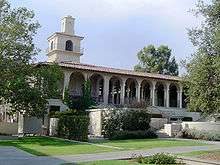
Occidental is one of the five schools that founded the Southern California Intercollegiate Athletic Conference (SCIAC) in 1915 and is currently a member of the SCIAC and NCAA Division III. Occidental features 21 varsity sports teams and a program of club sports and intramural competition. Approximately 25 percent of the student body participates in a varsity sports program.[72]
During the 2006–2007 athletic season, the Tigers cross country, American football and basketball teams were Southern California Intercollegiate Athletic Conference champions. In 2014, diver Jessica Robson set the Southern California Intercollegiate Athletic Conference records for both 1m and 3m diving.[73] The school's Blackshirts Rugby union team was also league champion for the first time in five years. In 2011, Jeremy Castro ('99) and Patrick Guthrie ('86) steered the squad to a NSCRO final, falling to Longwood University 36-27 in Virginia Beach, Virginia. In addition the college has a dance team that also performs at every home football and basketball game.[72]
Occidental athletics date back to 1894, when the College helped organize the first intercollegiate athletic competition in Southern California.[74] Since then, Oxy has produced more than a dozen Olympians, world-record holders, and national champions, including 1935 national girls' tennis champion Pat Henry Yeomans '38, two-time diving gold medalist Sammy Lee '43, and pole vault silver medalist Bob Gutowski '57.
Occidental has long-standing football rivalries with Pomona College and Whittier College; the Tigers have played both the Sagehens and the Poets over 100 times. In 1982, the Occidental College football team had the rare opportunity for national prominence when, due to the 1982 National Football League strike, their game with San Diego was broadcast on national television. In 2017, Occidental cancelled the remainder of its football season due to lack of healthy players, as few as 30 in some cases. The team forfeited two games and was outscored in the other three 170-19.
In 2011, Occidental College lost a basketball game to Caltech with a score of 46 to 45 giving the Caltech Beavers their first conference win in 26 years and putting an end to their 310-game losing streak.[75]
Famous Occidental College Tigers include NFL coach Jim E. Mora, former American Football League Most Valuable Player and politician Jack Kemp, former NFL player Vance Mueller, 2011 U.S. Senior Open Champion Olin Browne, and CFL player Justin Goltz (Winnipeg Blue Bombers).
Notable people
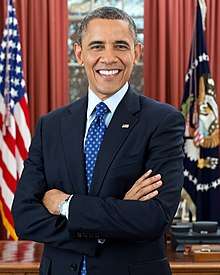
Notable graduates of Occidental College include filmmaker Terry Gilliam, football player and politician Jack Kemp, pioneering African-American physicist and inventor George Edward Alcorn Jr., former New Orleans Saints and Indianapolis Colts head coach Jim E. Mora, co-inventor of the hard disk drive William Goddard, federal judge Jacqueline Nguyen, historian and chancellor of the California State University system Glenn Dumke, former Lieutenant Governor of California Robert Finch, adventurer and writer Homer Lea, poet Robinson Jeffers, librarian and writer Lawrence Clark Powell, civil rights activist Ernesto Galarza, television director Jesus Salvador Trevino, journalist and current dean of Columbia University Graduate School of Journalism Steve Coll, actor and writer George Nader, veteran executive at Walt Disney Imagineering Joe Rohde, and CEO of Warner Music Group Stephen Cooper.
Notable alumni who did not graduate include the 44th U.S. President Barack Obama, former First Lady of Colorado Dottie Lamm, Academy Award–winning actor and filmmaker Ben Affleck, actor Luke Wilson, producer Todd Garner, and actress Emily Osment.
Notable faculty members include the American urban policy analyst Peter Dreier, former U.S. Ambassador Derek Shearer, former CNN and Fox News contributor Caroline Heldman, chemist Frank L. Lambert, and the 2005 PEN American Center Literary Award winner in poetry Martha Ronk.
Film and television at Occidental
Occidental's campus, architecture, and proximity to Hollywood have made it a desired location for a number of film and television productions.[76]
Film credits include:
- The Cup of Fury (1920) with Helene Chadwick
- The College Hero (1927) with Ben Turpin
- Horse Feathers (1932) with the Marx Brothers
- Pigskin Parade (1936) with Judy Garland and Betty Grable
- Second Chorus (1941) with Fred Astaire
- That Hagen Girl (1947) with Shirley Temple and Ronald Reagan
- Goodbye, My Fancy (1951) with Joan Crawford and Robert Young
- That's My Boy (1951) with Dean Martin
- Pat and Mike (1952) with Katharine Hepburn and Spencer Tracy
- Tall Story (1960) with Jane Fonda and Anthony Perkins
- Take Her, She's Mine (1963) with James Stewart
- The Impossible Years (1968) with David Niven
- The One and Only (1978) with Henry Winkler
- Star Trek III: The Search for Spock (1984) featuring the Gilman Fountain as part of the Palace of Vulcan
- Real Genius (1985) with Val Kilmer
- Sneakers (1992) with Robert Redford
- Clueless (1995) with Alicia Silverstone
- Kicking and Screaming (1995) with Josh Hamilton
- Don't Be a Menace to South Central While Drinking Your Juice in the Hood (1996) with the Wayans Brothers
- Boys and Girls (2000) with Freddie Prinze Jr.
- Jurassic Park III (2001) with Sam Neill
- Orange County (2002) with Colin Hanks and Jack Black
- House of the Dead 2: Dead Aim (2005) with Sticky Fingaz
- The Holiday (2006) with Cameron Diaz, Kate Winslet, Jude Law, and Jack Black
- Made of Honor (2008) with Patrick Dempsey and Michelle Monaghan
- Fired Up (2009) with Nicholas D'Agosto, Eric Christian Olsen, and Sarah Roemer
- Table for Three (2009) with Brandon Routh, Jesse Bradford and, Sophia Bush
- The Kids Are All Right (2010) with Annette Bening and Julianne Moore
- The Face of Love (2013) with Annette Bening, Ed Harris, and Robin Williams
TV credits include:
- Agents of S.H.I.E.L.D.
- Arrested Development
- Awkward
- Beverly Hills, 90210
- California's Gold
- Cannon
- Charmed
- Criminal Minds
- CSI
- Dragnet
- Eli Stone
- Glee
- Greek
- The Good Place
- Here and Now
- HGTV Star
- King of the Nerds
- Law and Order: Los Angeles
- Lethal Weapon
- The L Word
- Lou Grant
- Major Crimes
- Monk
- NCIS
- Parenthood
- Ray Donovan
- Remington Steele
- The Riches
- Rizzoli & Isles
- The Romanoffs
- Rome
- Snowfall
- Sweet/Vicious
- Switched at Birth
- Training Day
- True Blood
- Welcome to the Family
- The West Wing
See also
References
- As of June 30, 2019. "U.S. and Canadian 2019 NTSE Participating Institutions Listed by Fiscal Year 2019 Endowment Market Value, and Percentage Change in Market Value from FY18 to FY19 (Revised)". National Association of College and University Business Officers and TIAA. Retrieved April 22, 2020.
- https://nces.ed.gov/collegenavigator/?q=Occidental+College&s=all&id=120254
- "NAICU - Membership". Naicu.edu. Archived from the original on 2015-11-09. Retrieved 2017-07-15.
- Murphy, William S. (20 April 1987). "Occidental College: A Lively Center of Learning Turns 100". Los Angeles Times. Retrieved March 29, 2015.
- Rolle, Andrew (1986). "Occidental College: A Centennial History".
- Lin, Jan (April 18, 2012). "Occidental College in Highland Park: The Campus and the Community". KCET Los Angeles. Retrieved March 30, 2015.
- "Pomona Trustees Meet". Los Angeles Times. 26 May 1909.
- "New Charter for College". Los Angeles Times. 15 April 1910.
- "Ask Trustees to Reverse". Los Angeles Times. 11 April 1912.
- "Tells Students Way of Change". Los Angeles Times. 1 May 1912.
- "Oxy remains co-ed". Occidental College Archives. Archived from the original on 2015-04-02. Retrieved 30 March 2015.
- "Honored Name for Athletic Field". Los Angeles Times. 24 February 1916.
- Winter, Robert (2012). "Myron Hunt at Occidental College". Tailwater Press.
- Dunaway, David King (1989). Huxley in Hollywood. New York: Harper & Row. ISBN 9780385415910.
- "Archived copy". Archived from the original on May 19, 2012. Retrieved September 28, 2011.CS1 maint: archived copy as title (link)
- "Occidental College Japanese American Relocation". Occidental College Library Digital Archives. Retrieved 30 March 2015.
- "Two Rhodes Scholars Named at Occidental". Los Angeles Times. 21 December 1958.
- "What is Operation Crossroads Africa?". Operation Crossroads Africa. Archived from the original on 2015-04-02. Retrieved 30 March 2015.
- Fender, Nicholas (November 9, 2014). "Occidental College and Its Relationship to Eagle Rock and Highland Park, CA". Go Articles. Retrieved March 30, 2015.
- Goldstein, Amy (1988-04-02). "Slaughter to Quit U-MD. Post". The Washington Post. ISSN 0190-8286. Retrieved 2020-07-14.
- "Biography of Dr. John B. Slaughter, Director of the NSF from December 1980 - October 1982". National Science Foundation. Retrieved 2020-07-14.
- "Mission". Occidental College. Retrieved 30 March 2015.
- Wallace, Amy (Spring 1996). "Occidental College's Noble Experiment in Diversity". The Journal of Blacks in Higher Education. The JBHE Foundation. 11 (11): 114–117. doi:10.2307/2963331. JSTOR 2963331.
- "Occidental College". Forbes. Retrieved 2019-04-12.
- Grange, Lori (November 15, 1990). "Occidental Removes Cross From Chapel". Los Angeles Times. Retrieved March 30, 2015.
- "A Brief History of Occidental College". Archived from the original on August 19, 2007. Retrieved August 2, 2007.
- Tokita, Mary (February 15, 2011). "An Interview With Occidental College President Jonathan Veitch". Eagle Rock Patch. Retrieved March 30, 2015.
- "U.S. Department of Education Releases List of Higher Education Institutions with Open Title IX Sexual Violence Investigations". U.S. Department of Education. Retrieved 14 July 2014.
- "Ruth Jones named new Title IX coordinator". The Occidental Weekly. Archived from the original on 2014-09-04. Retrieved 2014-08-23.
- "Sexual Assault Resources & Support | Occidental College | The Liberal Arts College in Los Angeles". Oxy.edu. Retrieved 2014-08-23.
- "Changing the Culture | Occidental College | The Liberal Arts College in Los Angeles". Oxy.edu. Retrieved 2014-08-23.
- "Occidental College" (PDF). 2.ed.gov. Retrieved 2017-07-15.
- Abcarian, Robin (30 May 2012). "'Birthers' claim Obama applied to college as a foreigner". Los Angeles Times. Retrieved 30 March 2015.
- Watanabe, Teresa (2020-02-11). "New Occidental College president hailed for diversity efforts". Los Angeles Times. Retrieved 2020-07-14.
- Landon, Olivia; Selassie, Manna (25 March 2014). "Hunting for Occidental's Past: A History of Architecture and Landscaping on Campus". The Occidental Weekly. Archived from the original on April 2, 2015. Retrieved 30 March 2015.
- McGuire, Diane Kostial; Fern, Lois (1 January 1982). Beatrix Jones Farrand (1872–1959) – Fifty Years of American Landscape Architecture. Dumbarton Oaks.
- Don, Shirley (June 21, 1998). "Alfresco Has Landed Again in Eagle Rock". Los Angeles Times. Retrieved July 3, 2020.
- Borja, Rhea (July 11, 2011). "Occidental Children's Theater: 'Trumpelstiltskin'". Patch. Retrieved July 3, 2020.
- Tranquada, Jim (July 10, 2019). "Occidental Children's Theater Runs Through August 24". Occidental College. Retrieved July 3, 2020.
- Creamer, Alyssa (August 9, 2012). "Most Beautiful Schools Ranked By Newsweek, College Prowler On Student, Campus Attractiveness". Huffington Post. Retrieved March 30, 2015.
- Singh, Ajay (January 10, 2013). "Occidental College Solar Array Nears Completion". Eagle Rock Patch. Retrieved March 30, 2015.
- Rees, Brenda (7 January 2013). "Occidental College prepares to plug in to solar power". The Eastsider. Retrieved 30 March 2015.
- "Admission Facts". Occidental College. Retrieved June 12, 2018.
- "America's Top Colleges 2019". Forbes. Retrieved August 15, 2019.
- "U.S. College Rankings 2020". Wall Street Journal/Times Higher Education. Retrieved September 26, 2019.
- "Best Colleges 2020: National Liberal Arts Colleges Rankings". U.S. News & World Report. Retrieved September 8, 2019.
- "2019 Liberal Arts Rankings". Washington Monthly. Retrieved September 8, 2019.
- "List of National Award Winners". oxy.edu. Archived from the original on April 13, 2011.
- "America's Top Colleges 2019". Forbes. Retrieved September 8, 2019.
- "Occidental College Rankings". U.S. News & World Report. 2020. Retrieved September 29, 2019.
- "Occidental College Ranking". Kiplinger. July 2019. Retrieved September 29, 2019.
- "Occidental College Common Data Set 2018-19".
- "Occidental College Common Data Set 2017-18".
- "Occidental College Common Data Set 2016/2017" (PDF). oxy.edu.
- "Occidental College Common Data Set 2015/2016" (PDF). oxy.edu.
- "Occidental College Common Data Set 2014/2015" (PDF). oxy.edu.
- "Occidental College Common Data Set 2013/2014" (PDF). oxy.edu.
- "Occidental College Common Data Set 2012/2013" (PDF). oxy.edu.
- "Occidental College Common Data Set 2016/2017" (PDF). oxy.edu.
- "Occidental College Common Data Set 2016/2017" (PDF). oxy.edu.
- "The Class of 2020: By the Numbers". oxy.edu.
- "Core Program". Occidental College. Retrieved March 27, 2015.
- "Convocation | Occidental College | The Liberal Arts College in Los Angeles". Oxy.edu. 2012-08-29. Retrieved 2017-07-15.
- "Oxy Traditions | Occidental College | The Liberal Arts College in Los Angeles". Oxy.edu. Retrieved 2014-08-23.
- "Residence Halls". Occidental College.
- "About". Occidental Weekly. Archived from the original on 2013-03-29. Retrieved 27 March 2013.
- "About". KOXY website. Retrieved 27 March 2013.
- Anderson, Dick (Summer 2013). "Taking Home Oscar". Occidental Magazine. Occidental College.
- "Winners Announced for 2013 Student Academy Awards". Academy of Motion Picture Arts and Sciences. Retrieved April 25, 2014.
- "Student Life". Occidental College. Retrieved 30 March 2015.
- "Student Life". Occidental College. Retrieved 11 May 2018.
- "Occidental College Athletics". Archived from the original on August 4, 2007. Retrieved August 2, 2007.
- "SCIAC Is Proud To Announce Women's Swimming and Diving All-Conference". SCIAC. 2014-03-03. Retrieved 2016-03-10.
- Rolle, Andrew (1986) Occidental College: A Centennial History, p. 14
- "The Caltech Beavers men's basketball team finally solves equation". ESPN. February 24, 2011. Retrieved July 15, 2017.
- "As A Movie Location". Occidental College. Archived from the original on 21 February 2013. Retrieved 30 March 2015.
Further reading
- Silverstein, Stuart (March 16, 2005). "Fired Campus Radio 'Shock Jock' Sues College". Los Angeles Times: 4. Retrieved March 30, 2013.
- Sanchez, Conor L. (March 3, 2006). "College 101: Working For Your Social Life". Santa Fe New Mexican: D3. Retrieved March 30, 2013.
- Dobuzinskis, Alex (October 20, 2007). "Ex-'Shock Jock' Settles Suit". Los Angeles Daily News: N6. Retrieved March 30, 2013.
